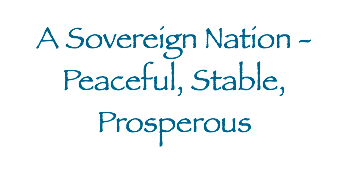
The Republic of Palau is one of the most beautiful, most pristine island nations on earth, and its people among the most hospitable.

Palau's most popular dive site, Blue Corner, is recognized as one of the best in the world.
The Republic of Palau is a collection of more than 250 islands, of which only eight are permanently inhabited. It has a total permanent population of just over 21,000, and more than 140,000 tourists per year (2014). Primarily known as one of the best scuba diving sites in the world, Palau also boasts great fishing, surfing, sailing, ocean kayaking, hiking, and cultural attractions.

Palau is nestled between the Pacific Ocean and the Philippine Sea, situated north of Papua New Guinea and east of the Philippines. Climate
Climate
Palau has an ideal topical climate all year round with an annual average temperature of 82° degrees F (27° C). Rainfall can occur throughout the year and the annual average is 150 inches (381 cm), with rainfalls more frequent between July and October. The average relative humidity is 82%. Typhoons are rare as Palau is located outside the typhoon zone.

PHOTO: Keobel SakumaPalau boasts great fishing, surfing, sailing, ocean kayaking, hiking, and cultural attractions.Geography
The Palauan archipelago is made of up of Koror, Babeldaob, Peleliu, Angaur, Kayangel, Ngeruangel and the remote Southwest Islands. The islands share maritime boundaries with Indonesia, the Philippines, and the Federated States of Micronesia. Palau is comprised of numerous island and reef types, varying geologically from mountainous volcanic islands, atolls and limestone islands, to low coral islands, usually fringed by large barrier reefs.
Languages
The designated official languages of Palau are Palauan and English, with English being the primarily spoken language.
Time Zone
Palau is ideally situated on the edge of the Pacific Rim, in the same neighborhood as Guam and the Philippines, and in the same time zone as Tokyo and Seoul.
Transportation
Palau International Airport is served by several large airlines, including Asiana Airlines, China Airlines, Delta Airlines, Japan Airlines, Korean Air, and United Airlines. Visitors can travel with any international carrier airlines from major metropolitan airport centers around the world, with layover transit in ROC Taiwan, South Korea, Japan, Philippines or Guam, which then connect with airlines with direct service to Palau. Transportation between islands mostly relies on private boats and domestic air services.

With its diverse marine life and pristine environment, Palau is a world-renowned scuba-diving and snorkeling destination.Tourism
Palau is number one in the Pacific Region in tourism percentage growth. The Palau Island Times reported that a record-breaking number of 140,784 tourists visited Palau in 2014, based on data from the Palau Visitors Authority (PVA). The number is the highest ever-recorded since Palau became an independent nation 20 years ago. The previous highest number was 124,286 arrivals in 2012. The 2014 arrivals surpassed the 2013 arrivals by 35,178 or 34 percent. Arrivals in 2013 totaled 105,066. The number of tourism visitors is expected to continue increasing.

Limestone rock islands. The picturesque Republic of Palau forms an island chain southeast of the Philippines with some 250 islets.
Palau is among the world's most spectacular diving and snorkelling destinations. Its coral reefs, wartime wrecks, hidden caves and amazing range of coral, fish and rare sea creatures makes it a popular tourist destination. Tourists from China, Japan, Taiwan and Korea make up 70% (98,550 in 2014) of Palau’s tourism market as they seek to escape harsh winters, severe pollution and densely populated cities. It is also fast becoming a popular destination for tourists from the United States, Germany, Europe, Guam, Australia, New Zealand and Russia. Twenty percent (20%) of Palau’s inbound tourists are repeat visitors.

Palau was made part of the United States-governed Trust Territory of the Pacific Islands in 1947. Palau gained its full sovereignty in 1994 upon the signing of the Compact of Free Association with the United States. Politically, Palau is a multi-party democratic republic in free association with the Unites States, which provides defense, funding, and access to social services.

President of Palau, Tommy Remengesau, receives the Champions of the Earth Award 2014 for Policy Leadership from UNEP. The island nation’s President announced in 2013 his intent to protect 80% of Palau’s waters as a National Marine Sanctuary.

Legal and Judicial System
Modeled after the United States form of government, Palau is a stable, modern democracy. The legal system in Palau is based on U.S. case law. There are U.S. attorneys in private practice and on contract to the Palau Judiciary, serving as prosecutors, judges, and government counsel.
Economy
Palau is very stable politically and this shows in the World Bank’s rating of its economy and the ease of doing business. Tourist activity is the nation's main economic driver. The economy also consists of subsistence agriculture and fishing. The government is the largest employer, relying heavily on U.S. financial assistance. Palau is also blessed with a wealth of human resources and technical capabilities. The population of Palau is well-educated and makes use of the advanced technologies on a daily basis.
Taxation
At 4% Gross Revenue Tax (GRT) on businesses, 0% general sales tax, and no property tax, Palau is considered to be an extremely tax friendly country. Except for food, Palau charges a flat three percent ad valorem duty on most imports; import duties for alcohol and tobacco are higher. Immediate personal property imports (such as furniture for use in an investor’s private home) are exempt from import duty. Palau also charges a fuel import tax of five cents per gallon on all imported diesel and gasoline.
Currency & Credit Cards
The official currency of Palau is the U.S. Dollar. Visa, JCB, and Master Card are widely accepted at stores and visitor facilities. There are several banks and financial institutions, including Bank of Hawaii, Bank of Guam, Bankpacific, Ltd, and Asia Pacific Commercial Bank, as well as major hotels with limited foreign currency exchange.

Koror–Babeldaob Bridge, built in 2002, connects Koror and Babeldaob Islands. Koror is Palau's largest commercial and population center.Infrastructure
Palau has U.S. and Japanese financed, designed and implemented infrastructure that is first rate. The roads, docks, airport, water, power, fuel storage and retail goods delivery systems are of an exceptionally high standard (superior to Bali and Thailand). Palau’s most populous state of Koror boasts a sealed road system, dependable sewer and electrical services, modern communication systems, hotels and resorts, banking and other business services, and dozens of wholesale and retail stores. Palau also has internet and cell phone services throughout the country.
Palau’s deepwater ports have regular container ship service. The country has a weekly barge service direct from Guam by Matson Lines and Kyowa Lines and other regional shipping companies service Palau. In addition, it has Fed Ex service and U.S. Postal Service (US Zip Code 96940).
Under the Compact of Free Association, the United States is committed to the defense of Palau, thereby creating a secure environment for investment. Although there is no military presence, Palau has a strong local police force and a very low crime rate.
Palau’s population provides a good workforce for new businesses, and can be supplemented with workers from nearby Micronesian Islands, the Philippines, Thailand, China, or other countries.

Above, Stone Monoliths, located in the north of Babeldaob Island, is one of Palau's historical landmarks.Neighbors
Guam is Palau’s closest neighbor and another U.S. island territory in Micronesia. It is directly linked to Palau politically, economically and culturally. It has also experienced tremendous tourism growth over the past five years.
Palau National Capital, Melekeok
- Photo by Bruce Whale


“...lush as any paradise of our imagination… a Living Eden where all is not what it seems—a home to a world of novelties concocted by nature unconstrained.”
- National Geographic on Palau

With its private islands, crystal blue waters, fluorescent creatures, and undisturbed rainforests, Palau is the perfect haven for adventure seekers, eco-tourists, and travelers looking for a stunning natural environment to explore. The region's wealth of biodiversity and natural resources is perfect for hiking, exploring, sailing, scuba diving and just observing this "Living Eden.”

Palau is one of the world’s best scuba diving getaways. Manta rays are often encountered by divers in the barrier reefs. These majestic rays can range in size from 4 to 7 meters and weigh more than one ton.Palau strives to preserve and conserve all of its precious resources. The current President of Palau, Tommy Remengesau, announced in 2013 his intent to protect 80% of Palau’s waters as a National Marine Sanctuary within the next few years. As home to some of the richest reefs on earth, the new offshore sanctuary will protect Palau's diversity and abundance of marine life.
"Palau is home to one of the highest number of species not found anywhere else in the world and its marine habitats support a greater density of coral, fish, and other invertebrates than any other place on Earth."- Palau Conservation Society
A Diver's Paradise
Palau is a diver's paradise of underwater riches, boasting more than 550 species of hard and soft corals, 300 sponge species, 1,400 species of reef fish, and seven of the world's nine species of giant clams. The concentration and variety of marine life is enormous and is nearly unrivaled across the planet. Among them are several endangered species: Hawksbill Turtle and Dugong (sea cow), as well as the reclusive Chambered Nautilus, and the rare Giant Clam.

Giant clams, the bottom-dwelling behemoths found in Palau, are the largest mollusks on Earth, capable of reaching 4 feet (1.2 meters) in length, weighing more than 500 pounds (227 kg), and have an average lifespan of over 100 years.The world-famous Blue Corner dive site offers a chance to hook in to the reef and be part of a rare underwater show of magnificent gorgonian fans, anemones, eels, sharks, eagle rays, large Napolean Wrass, and schools of jacks and black snappers as they swirl slowly around you. Divers can also explore hidden marine lakes and lagoons, like Jellyfish Lake in the Rock Islands, that are full of distinctive species like the non-stinging Mastigias and Moon Jellyfish. It's no wonder that Palau was chosen by the National Geographic Society as the first Underwater Wonder of the World.
A Terrestrial Treasure Trove
In addition to the world renowned underwater ecosystem, Palau's earthly terrain is equally stunning and biologically diverse. As visitors emerge from the water onto the pristine, white sandy beaches, they are met with an abundance of terrestrial wonders to explore, including flourishing rainforests, spectacular waterfalls, intriguing geological and archaeological sites, all serving as home to Micronesia’s richest and largest resident populations of bird, animal and plant species. It is estimated that Palau has over 1,260 species of plants, including over 800 native species and the endangered Rock Island Palm and Palau Palm.

Jellyfish Lake is a marine lake located on Eil Malk island, part of the Rock Islands. The lake is 12,000 years old, populated with moon jellyfish and the golden jellyfish, and connected to the ocean through fissures and tunnels in the limestone of an ancient Miocene reef.The main island of Babeldaob is recognized as one of the largest undisturbed tropical rainforests in Micronesia and is home to Ngardok Lake and Ngermeduu Bay, which are the largest natural lake and largest estuary in Micronesia, respectively. According to the Palau Conservation Society, the forest-covered big island of Babeldaob harbors hundreds of endemic animal and plant species, and is rapidly becoming known as a major archeological hotspot.
"Blue Corner is the main attraction for anyone diving in Palau. Rich deep waters hit the wall and rush to the surface, bringing up nutrients that attract all sorts of fish."
- National Geographic
Photo by Dr. Enric Sala








